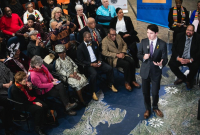Support strong Canadian climate journalism for 2025
A woman who helped build the black civil rights movement in Nova Scotia is being remembered as the behind-the-scenes power in a partnership that often featured her husband as the charismatic and public voice.
The daughter of Joan Jones said her mother died at a Halifax hospital on Monday night at the age of 79.
Tracey Jones-Grant, the oldest of five children, said her mother's "voice and touch were on many things" out of the public eye, including the formation of early civil rights groups alongside her husband, Burnley (Rocky) Jones in the 1960s and 70s.
The couple separated later in life, but friends say they remained friends up to Rocky Jones' death in 2013, say family friends.
Jones moved to the province from Toronto with her husband — who was a lawyer, activist and educator — in the early 1960s.
They created the Nova Scotia Project, an activist movement that led to the Black United Front, a group which challenged the racism and poverty that had plagued the province's black community for generations.
Jones-Grant said only looking back can they see the impact of her work.
"As a black woman, she's given a role model to black women to speak their truth. That's been important to me, to a young black woman growing up," she said. "She was powerfully direct."
Family members say while Rocky Jones was the public voice of the movement, it was often Joan who sat on the committee gatherings in their living room, and who would carefully review and even craft public statements.
"She was an activist behind the scenes and I think we often forget about those people," said Augy Jones, her 50-year-old son.
"Many of the projects attributed to my Dad, it was my mother who was on the organizing committees, and gave ideas ... even at home they bounced ideas off each other."
Jones also helped form the provincial Black History Month committee, which led to a massive public education campaign that is now embedded in the calendars of community centres and schools across the province.
In the early 1990s, Jones sat on a liaison committee with the police that helped encourage the training and hiring of black officers in a largely white force that had a tense relationship with the black community.
"She didn't talk a lot, but when she talked, people would listen ... she wanted some results," said Jones-Grant.
Walter Borden, an actor, playwright and poet, said his lifelong friend worked tirelessly through her life to build black organizations, with key meetings often taking place around the family's round table.
"Joan was the power behind the throne. It was something we all understood from Day 1, and I was there from Day 1," he said.
Her quiet leadership within the organizations was consistent with the behind-the-scene role black women played in most of the community's organizations, he said.
"There was no question of the woman being in control. No, this was the natural thing. There was nothing that ever came before the public as statement or speech that wasn't edited by Joan," he said.
Sgt. Craig Smith, a 57-year-old RCMP officer who worked with Jones in various community projects, said sitting on the police liaison committee with her taught him the power of "the social activism philosophy."
Police officers started to walk the beat in communities with large African Nova Scotian populations, and they were urged to visit young people in basketball programs and community centres as a result of the liaison community's work, said Smith.
Smith recalled Jones as having a direct, no-nonsense approach in conversation that sliced through rhetoric and cut to the heart of how to bring change about.
"She didn't call people out indiscriminately, but if there was an issue that needed to be dealt with she didn't sugar coat it," he said.





Comments